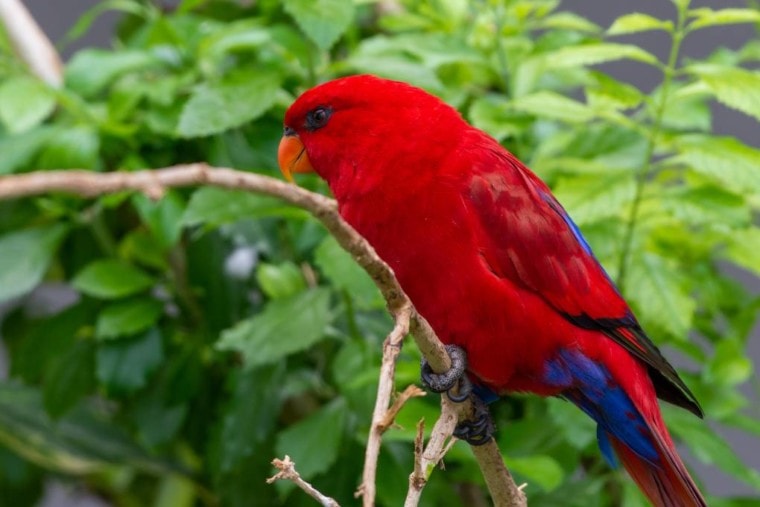
Of all the Lory bird morphs in the world, the red lory is one of the most popular that you’ll find in captivity today. These lory birds are known for their playful personalities and striking appearance. Lories require a lot more care and attention than most other companion birds. This necessitates a dutiful owner that is willing to devote the time to handle their particular needs.
Although this parrot is small, they have a big personality and bright colors that make you forget about their little size. Red Lories grow up to 12 inches long and weigh as little as 6 ounces. If you do decide that this bird is the right kind for you, expect to have them in your life for as long as 30 years.
 Species Overview
Species Overview
| Common Names: | Red Lory, Moluccan Lory |
| Scientific Name: | Eos Bornea |
| Adult Size: | 10 – 12 inches |
| Life Expectancy: | 15 – 30 years |
Origin and History
Red Lories are small parrots. They belong to the family called Psittaculidae. Lories, sometimes called Lorikeets, are most often found around Australia and other nearby islands like Indonesia and New Guinea. Red Lories are closely related to the Rainbow Lory.
Red Lories are the most common types that you’ll find in pet stores or bird specialty stores around the world. They breed readily in captivity and are common pets for experienced bird lovers. These birds originate from Indonesia, more specifically the Maluku islands. This is why you might sometimes hear them referred to a Maluccan Lories as well.

Red Lory Colors and Markings
The Red Lory bird is known for its deep, pomegranate red body. They have a few blue markings on their wings, tails, and faces. They also have an orange, curved beak. The most memorable feature of these animals, however, might be their tongues. Lory tongues resemble tiny brushes that they use to remove nectar and pollen from flowers in the wild. Here is a short list of some of the other popular Lory color variations.
 Caring for the Red Lory
Caring for the Red Lory
You should have some experience if you plan to own a Red Lory as a pet. These birds are highly intelligent and active. They have no problem getting into all sorts of trouble the moment you turn your back.
Red Lories are probably the messiest of all the companion birds you have to choose from. They have a mainly liquid diet, which means they defecate watery feces that can shoot pretty far distances. Even though they are small, they require large cages that give them the freedom to move around a lot. Red Lories have a very specific diet of fruit and nectar. They sometimes eat seeds, but too much isn’t natural to their original, wild diet. It is okay to feed them mealworms on occasion.
Try to refrain from bringing home a Red Lory if you have never owned a pet bird before. They are going to demand a lot of your time. They don’t necessarily require another bird to keep them company, but you might want to ask a local aviary expert if they believe their lives could be enriched by another bird around.

Where to Adopt and Buy a Red Lory
Research is the most crucial part of purchasing a new pet, but this is especially true for Red Lories. Red Lories are usually readily available at most pet stores or bird specialty stores.
Bird Breeders
The best way to adopt or buy a Red Lory is through a bird breeder. Only purchase from breeders who are registered or certified to do so. Because the Red Lory is prone to metabolic disorders, hemochromatosis, or iron storage disease, you have a better chance of avoiding these issues if you buy from a breeder with healthy bloodlines.
Ask to see paperwork from all breeders before buying them. If possible, go out to the breeder’s site and take a look around. There is a lot to tell about a breeder based on the bird’s environment. If they aren’t being raised in a humane way, then it is better to assume that this isn’t the breeder for you.
Adopting a Red Lory
A cheaper method might be to adopt a lory from a bird rescue group or local shelter. This process might be a little more challenging. You’ll have to check for Red Lory availability on a consistent basis if you prefer to obtain a bird this way instead of through a breeder.
 Conclusion
Conclusion
The Red Lory is a chatty, active, and fun bird species to have if you’re a bird fancier. Even though there are quite a few morphs or lories to choose from, the Red Lory has become a household favorite for a good reason. Their striking red bodies are what first grabs your attention, but it’s the constant companionship of having these birds around that get you hooked.
We hope that this short Red Lory article has helped you better understand the Red Lory and how it interacts with humans, its basic needs, and other possible variations of this bird. While they aren’t the best choice for beginners, you can certainly work your way up in experience. Pretty soon, you’ll have a new Red Lory friend at your side every time you walk through the door.
See also:
- 12 Types of Lorikeets that Make Great Pets (with Pictures)
- Do Lorikeets Make Great Pets? Everything You Need To Know
Featured Image Credit: Kingma Photos, Shutterstock
 Species Overview
Species Overview Caring for the Red Lory
Caring for the Red Lory





